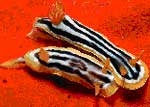In Vietnam, the green pit viper is a species with a wide distribution and poses a potential danger to humans due to its ability to camouflage with its surroundings. However, few people know that there are up to 7 different species of green pit vipers living in our country.
When you encounter a green pit viper, distinguishing between them is not easy. This article will help everyone quickly recognize the various species of green pit vipers. The following information is shared by the Vietnam Amphibian and Reptile page.
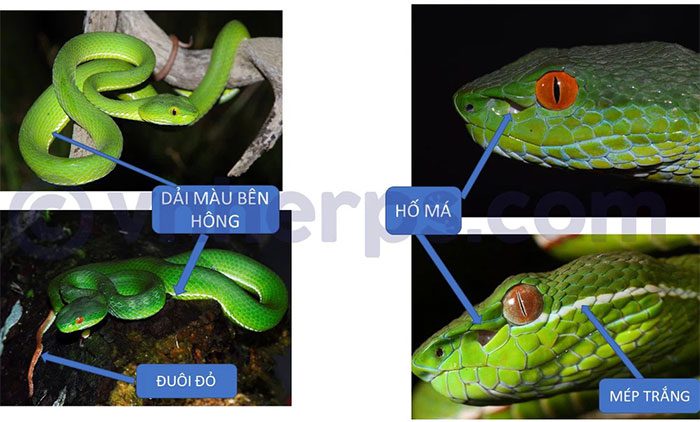
Basic points to identify green pit vipers.
The green pit viper family in Vietnam consists of about 22 to 24 recorded species, belonging to the Viperidae family with 7 genera. The species in this group predominantly feature green and brown colors. This article will focus on 7 species that have distinctive green colors and are easily confused due to their similar appearances.
Those unfamiliar with snakes often refer to them as red-tailed green pit vipers, but in fact, there are seven different species including:
- 1. Trimeresurus albolabris: White-lipped pit viper (most common)
- 2. Trimeresurus vogeli: Vogel’s pit viper
- 3. Trimeresurus stejnegeri: Stejneger’s pit viper
- 4. Trimeresurus rubeus: Southern red-eyed pit viper
- 5. Trimeresurus cardamomensis: Cardamom green pit viper
- 6. Trimeresurus guoi: Guo’s pit viper
- 7. Trimeresurus gumprechti: Gumprecht’s green pit viper
To differentiate between these green pit viper species, we need to look at their eye color, geographical location, the coloration of their cheeks (pinkish or pale white) and finally, the color of their tails. We will explore each species in greater detail in the following sections.
We will categorize the species into 3 main groups based on eye color, distribution, and the presence of a white stripe under the eyes. Specifically, refer to the image below:
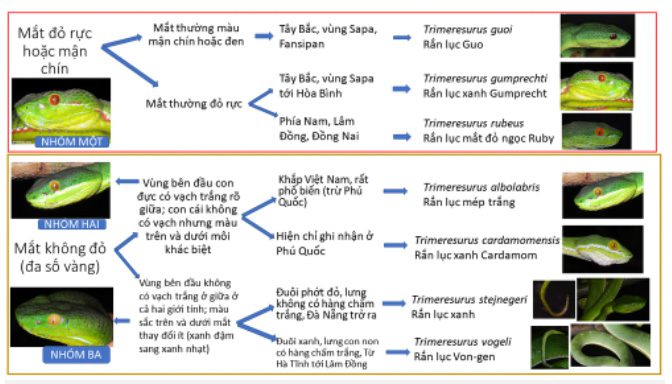
Quickly differentiate between green pit viper species. (Image: Vietnam Amphibian and Reptile).
Group 1: Red or plum-colored eyes (3 species)
- If the eyes are black or plum-colored with a yellow or white stripe on the side, found only in the Northwestern region, it is the Guo’s pit viper; Trimeresurus guoi.
- If the eyes are red and have a red stripe on the side, found in the Northwestern area from Hoa Binh to Lao Cai, it is Gumprecht’s pit viper; Trimeresurus gumprechti.
- If the eyes are red and located in the South, such as Lam Dong or Dong Nai and nearby areas, it is the red-eyed or ruby pit viper, Trimeresurus rubeus.
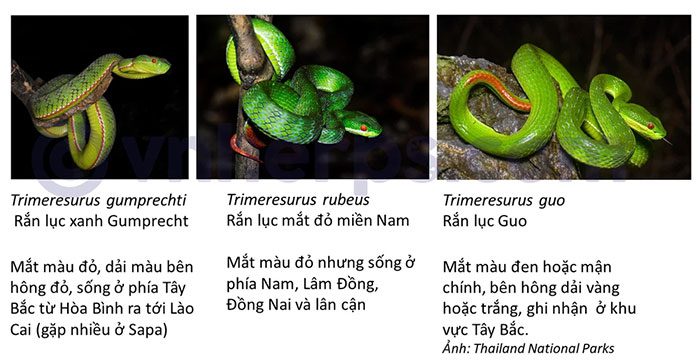
For Group 1, with red eye color, we need additional information for identification. (Image: Thailand National Parks).
Group 2 (2 species): Non-red eyes
If the eyes are not red but brown, light yellow, or possibly copper-colored, we should look at the cheeks; specifically, males have a distinct white stripe, while females have two clearly separated colors (green on the upper edge and yellow on the lower lip).
These two species are very similar, so identification should rely on the location found: The Cardamom green pit viper is only recorded on Phu Quoc Island, Kien Giang Province, while the white-lipped pit viper is found throughout most of Vietnam.
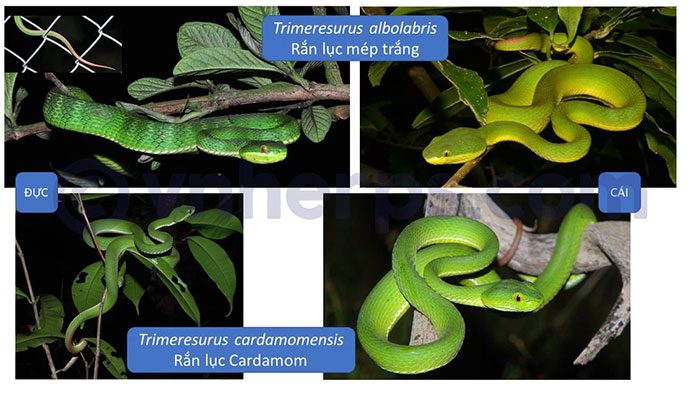
Distinguishing the two species in Group 2. (Image: Vietnam Amphibian and Reptile).
Group 3 (2 species): Cheeks with white stripes
Both have copper or brown eyes like Group 2, but their cheeks do not have white stripes, typically being uniformly green or transitioning from dark green on top to lighter beneath the mouth.
These are the two most difficult species to distinguish, even for those specialized in taxonomy. They can be identified as follows:
- Juveniles usually have white spots on their backs, a completely green tail, and are found from Ha Tinh to Lam Dong: Vogel’s pit viper; Trimeresurus vogeli.
- With a reddish-brown tail tip and no white spots on the back, they live from Da Nang northward: Stejneger’s pit viper; Trimeresurus stejnegeri.
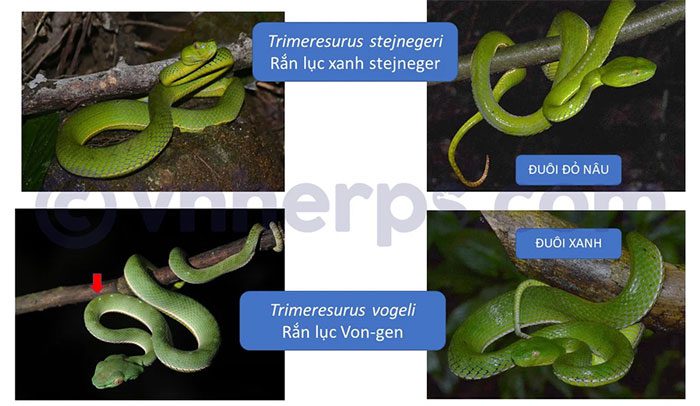
Group 3 consists of 2 very similar species. (Image: Vietnam Amphibian and Reptile)
The above are quick identification methods for most people, even those who are not specialists in snake classification. All 7 species listed are venomous and related to necrotic venom, but they will not be fatal if treated promptly.
If accidentally bitten by a red-tailed green pit viper, absolutely do not use a tourniquet, suck out the venom, or apply unverified remedies. Instead, provide first aid (apply a light splint similar to treating a broken arm or leg) and then take the victim to the nearest medical facility for assistance.










































